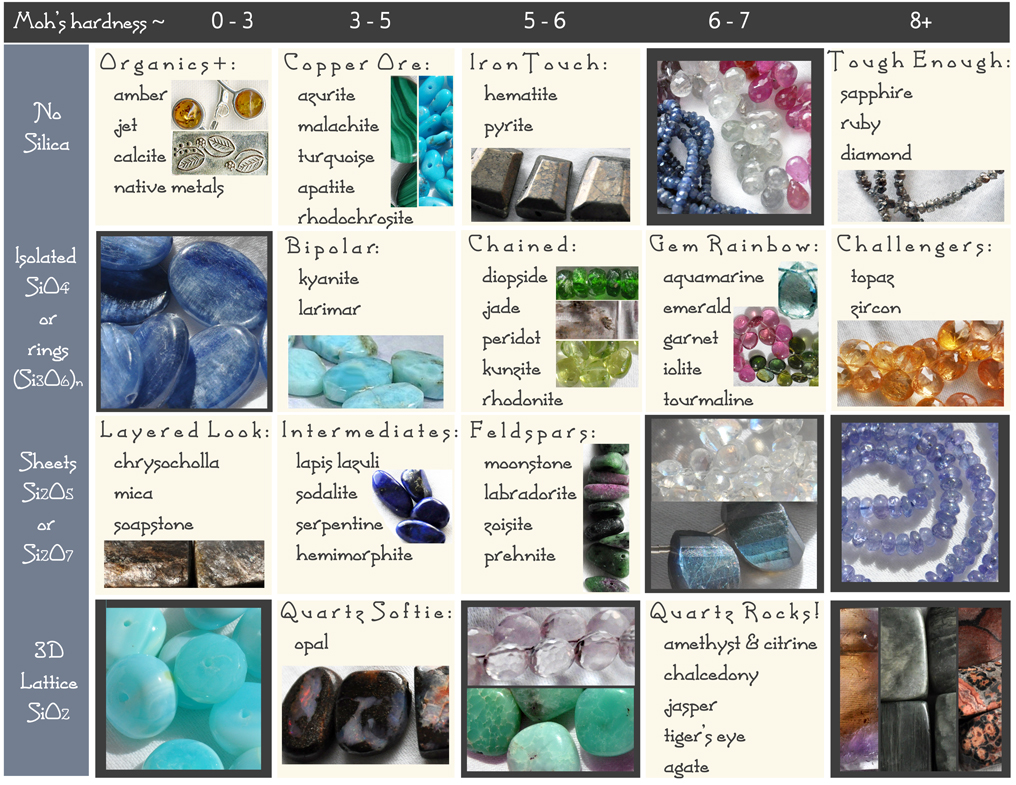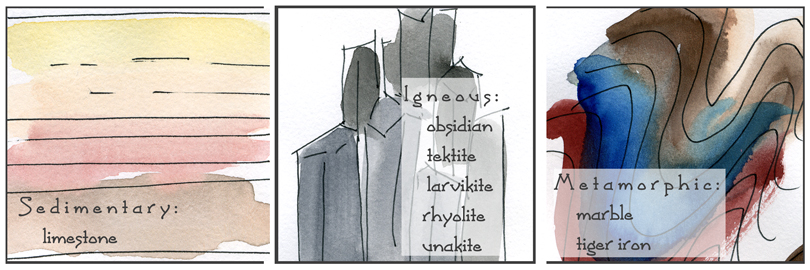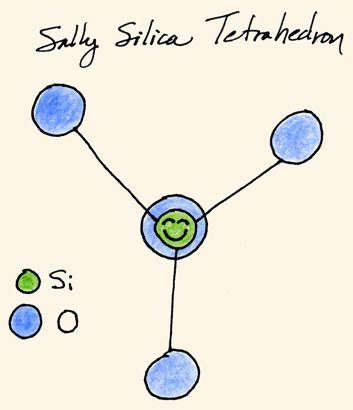m i n e r a l s & r o c k s
The difference between rocks and minerals is like the difference between ice cream and sugar; rocks are
made of minerals. Minerals are defined as any naturally occurring inorganic solid that possesses an orderly
crystalline structure and a definite chemical composition. Table salt is a mineral made of
sodium-chloride (NaCl). Granite is a common igneous rock made from a variety of minerals. For example,
unakite is a kind of granite with the mineral epidote giving it the olive green color.
•• m i n e r a l s g r o u p e d b y h a r d n e s s a n d s t r u c t u r e
The grid below is a way to visualize precious and semi-precious gemstones by their hardness and crystalline structure.
The grid
separates minerals by Moh's hardness (increasing from soft to hard, from left to right) and silica organization
(from silica-poor to silica-rich, from top to bottom). The hardest minerals are corundrum (sapphire & ruby) and
diamond, formed under conditions of extreme heat and pressure, and the softest result
from deposition and lithification of sedimentary rock or organic material.

•• r o c k t y p e s a n d t h e r o c k l i f e c y c l e

The rock life cycle begins with magma (igneous rock) that cools above or below ground. Weathering and erosion
break down the rock into sediments, which can be cemented together through lithification into sedimentary rock.
Igneous and/or sedimentary rocks subjected to heat and pressure from tectonic motion form metamorphic rock.
Tectonic plate motion may drive rocks back into a molten state (magma) and the whole cycle begins again.
Some jewelry components are made from stones containing a variety of minerals. Marble is a metamorphic rock formed from
limestone; which itself is a sedimentary rock formed from
calcium carbonate (calcite) deposits. Obsidian a glass-like igneous rock that forms during rapid cooling of
lava. Then there's the granites: larvikite is an unusual blue-gray granite that's
found in Norway and also called "blue labradorite" because it displays similar schiller
characteristics (iridescence); rhyolite is a quartz and feldspar garnet in a variety of colors and
patterns; and unakite is a granite made of epidote and pink feldspar. Therefore, the following stones are
grouped according to rock type rather than mineral composition.
Rock types:
f u n f a c t s :

Meet Sally Silica Tetrahedron! Sally is a chemical building block made of 4 oxygen (O) atoms and 1 silicon (Si) atom
arranged in a pyramidal structure. What's special about Sally? It turns out that she is useful for understanding
mineral groups. Some minerals lack Sally, some minerals have Sally in small isolated quantities, some minerals
have Sally in connected strings or sheets, and some minerals are mostly Sally! Minerals can be grouped by the
organization and relative proportion of oxygen to silicon - none, 4:1, 3:1 and 2:1 - reflecting how silica
tetrahedron are arranged in the chemical structure. Quartz, for example, is all Sally: SiO2, meaning that the
corners of the oxygen pyramid are shared between silicon atoms.

The grid
separates minerals by Moh's hardness (increasing from soft to hard, from left to right) and silica organization
(from silica-poor to silica-rich, from top to bottom). The hardest minerals are corundrum (sapphire & ruby) and
diamond, formed under conditions of extreme heat and pressure, and the softest result
from deposition and lithification of sedimentary rock or organic material.
Mineral Groups:
No silica
- Organics+ (amber, jet, calcite, silver, gold, copper)
- Copper Ore (turquoise, malachite, azurite, apatite, rhodochrosite)
- Iron Touch (hematite, pyrite)
- Tough Enough (diamond, ruby, sapphire)
Silica-poor (Isolated tetrahedra or chains)
- Bipolar (kyanite, larimar)
- Chained (diopside, peridot, jade, kunzite, rhodonite)
- Gem Rainbow (garnet, tourmaline, iolite, emerald, aquamarine)
- Challengers (zircon, topaz)
Silica sheets
Silica-rich
For fun, I named the categories based on member minerals and properties. "Organics+"
refer to minerals made from calcium carbonate (byproducts from organic creatures like corals) or
native metals like silver, copper or gold. "Challengers" refer to minerals that are most
like the "toughest" minerals in hardness. You'll note that the hardest minerals are also
the minerals found in igneous or methamorphic rock; the softer minerals tend to be found in
sedimentary rock. "Copper Ore" contains turquoise, malachite, azurite and other minerals
commonly found near copper veins. Although opal has similar chemical composition to quartz, it
lacks the crystalline organization, making it "soft" compared to its cousins.
"Bipolar" is the group containing kyanite, which is remarkable in that it has two Moh's
hardness values, depending whether the mineral is split along its fibers or across them.
Beryls (aquamarine, emerald), topaz and tourmaline form in a special kind of igneous rock called pegamite
that forms at the edges of massive underground magma flows. It's the presence of water that leads to
unusually large crystals forming; for silica rich magma flows, the crystals are more likely to be quartz-like
(more silicon). For silica-poor magma, the crystals are likely to be more feldspar-like (less silicon).
Though any given mineral may be found in a rock, the type of rock and conditions under which it forms
tend to influence its mineral content and appearance.
•••


 The rock life cycle begins with magma (igneous rock) that cools above or below ground. Weathering and erosion
break down the rock into sediments, which can be cemented together through lithification into sedimentary rock.
Igneous and/or sedimentary rocks subjected to heat and pressure from tectonic motion form metamorphic rock.
Tectonic plate motion may drive rocks back into a molten state (magma) and the whole cycle begins again.
Some jewelry components are made from stones containing a variety of minerals. Marble is a metamorphic rock formed from
limestone; which itself is a sedimentary rock formed from
calcium carbonate (calcite) deposits. Obsidian a glass-like igneous rock that forms during rapid cooling of
lava. Then there's the granites: larvikite is an unusual blue-gray granite that's
found in Norway and also called "blue labradorite" because it displays similar schiller
characteristics (iridescence); rhyolite is a quartz and feldspar garnet in a variety of colors and
patterns; and unakite is a granite made of epidote and pink feldspar. Therefore, the following stones are
grouped according to rock type rather than mineral composition.
Rock types:
The rock life cycle begins with magma (igneous rock) that cools above or below ground. Weathering and erosion
break down the rock into sediments, which can be cemented together through lithification into sedimentary rock.
Igneous and/or sedimentary rocks subjected to heat and pressure from tectonic motion form metamorphic rock.
Tectonic plate motion may drive rocks back into a molten state (magma) and the whole cycle begins again.
Some jewelry components are made from stones containing a variety of minerals. Marble is a metamorphic rock formed from
limestone; which itself is a sedimentary rock formed from
calcium carbonate (calcite) deposits. Obsidian a glass-like igneous rock that forms during rapid cooling of
lava. Then there's the granites: larvikite is an unusual blue-gray granite that's
found in Norway and also called "blue labradorite" because it displays similar schiller
characteristics (iridescence); rhyolite is a quartz and feldspar garnet in a variety of colors and
patterns; and unakite is a granite made of epidote and pink feldspar. Therefore, the following stones are
grouped according to rock type rather than mineral composition.
Rock types:
 Meet Sally Silica Tetrahedron! Sally is a chemical building block made of 4 oxygen (O) atoms and 1 silicon (Si) atom
arranged in a pyramidal structure. What's special about Sally? It turns out that she is useful for understanding
mineral groups. Some minerals lack Sally, some minerals have Sally in small isolated quantities, some minerals
have Sally in connected strings or sheets, and some minerals are mostly Sally! Minerals can be grouped by the
organization and relative proportion of oxygen to silicon - none, 4:1, 3:1 and 2:1 - reflecting how silica
tetrahedron are arranged in the chemical structure. Quartz, for example, is all Sally: SiO2, meaning that the
corners of the oxygen pyramid are shared between silicon atoms.
Meet Sally Silica Tetrahedron! Sally is a chemical building block made of 4 oxygen (O) atoms and 1 silicon (Si) atom
arranged in a pyramidal structure. What's special about Sally? It turns out that she is useful for understanding
mineral groups. Some minerals lack Sally, some minerals have Sally in small isolated quantities, some minerals
have Sally in connected strings or sheets, and some minerals are mostly Sally! Minerals can be grouped by the
organization and relative proportion of oxygen to silicon - none, 4:1, 3:1 and 2:1 - reflecting how silica
tetrahedron are arranged in the chemical structure. Quartz, for example, is all Sally: SiO2, meaning that the
corners of the oxygen pyramid are shared between silicon atoms.
 The grid
separates minerals by Moh's hardness (increasing from soft to hard, from left to right) and silica organization
(from silica-poor to silica-rich, from top to bottom). The hardest minerals are corundrum (sapphire & ruby) and
diamond, formed under conditions of extreme heat and pressure, and the softest result
from deposition and lithification of sedimentary rock or organic material.
Mineral Groups:
The grid
separates minerals by Moh's hardness (increasing from soft to hard, from left to right) and silica organization
(from silica-poor to silica-rich, from top to bottom). The hardest minerals are corundrum (sapphire & ruby) and
diamond, formed under conditions of extreme heat and pressure, and the softest result
from deposition and lithification of sedimentary rock or organic material.
Mineral Groups: